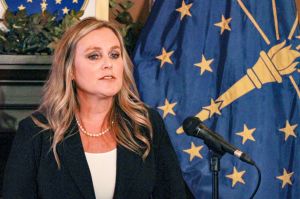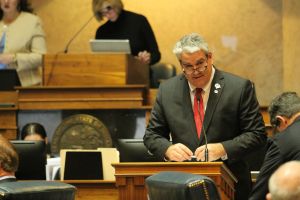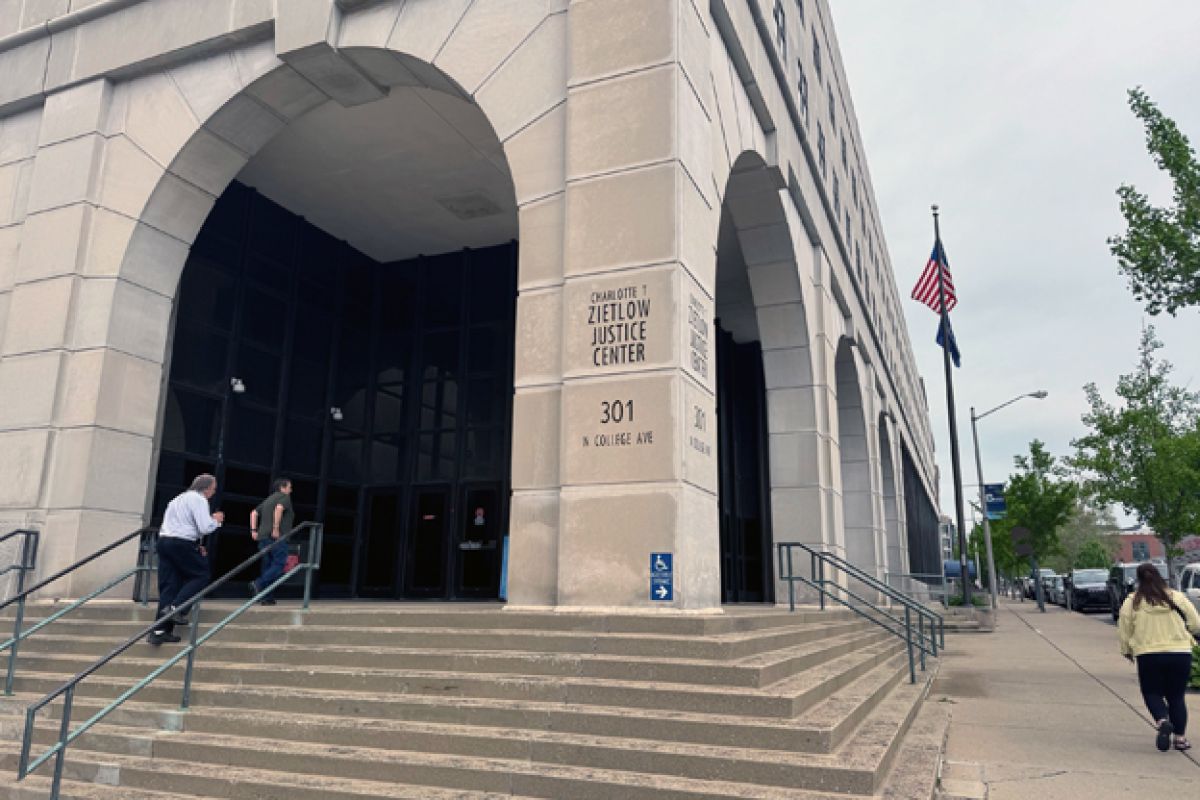
Monroe County Justice Building (Joe Hren, WFIU/WTIU News)
Bloomington’s annexation trial over the remonstrance results of areas 1A and 1B is complete. WFIU/WTIU's Joe Hren is covering every day of the City of Bloomington's annexation trial. Daily coverage can be found below.
Bloomington Mayor John Hamilton's administration plans to annex 8,350 acres and 14,000 people into the city by 2024. The issue is being hotly debated by officials and Monroe County residents who would be affected. Hamilton says the city's last annexation took place in 2004, and the city will fall behind if it doesn't make additions.
The idea is not new, and was first put forward in 2017. But plans were interrupted by an addition to that year's legislative budget: Section 11.8 which prohibited annexation action proposed in the first six months of 2017. The city called Section 11.8 a legislative overreach and brought a lawsuit against Gov. Eric Holcomb to the Indiana Supreme Court. The court ruled in favor of Bloomington in December 2020 and annexation continued the next year.
Bloomington City Council adopted annexation ordinances in September 2021. The remonstration window ended January 6, 2022 and certified results void 5 of the 7 areas for annexation. A hearing on the constitutionally of waivers used during the remonstrance period for those areas was March 15. A decision has not yet been reached.
This is the trial of areas 1A and 1B. Those are the two proposed annexed areas that had more than 51 percent of remonstrance signatures, but less than the 65 percent needed to overturn annexation.

Pushing City Limits: Bloomington Annexation Coverage
Case Number: 53C06-2203-PL-000509 | City of Bloomington Annexation
Annexation opponents, CRAA, are being represented by William J. Beggs with Bloomington-based Bunger & Robertson. The city is being represented by Andrew McNeil with Indianapolis-based Bose McKinney & Evans along with city legal including counsel Margie Rice.
Estimated population before 2020 census: 1A 3,987 | 1B 4,566
Trial: Charlotte Zietlow Justice Center Monday April, 29 through Friday, May 3 | 9 a.m. - 4 p.m. | courtroom 313
Annexation Trial Testimony Order:
Defendant - City of Bloomington
- John Hamilton, former mayor of Bloomington
- Vic Kelson, former city utilities director
- Adam Wason, city public works director
- Meghan Blair, GIS manager
- David Rusk, urban policy consultant
- Eric Reedy, Reedy Financial Group
- Michael Diekhoff, chief of police
- Roger Kerr, fire chief
- Kerry Thomson, mayor of Bloomington
Plaintiff - County Residents Against Annexation
- Cheryl Sciscoe, resident 1A
- Harry Ferris, resident 1A
- Rhonda Gray, resident 1B
- Thomas McGhie, resident 1B
- Barbara Leininger, resident 1B
- William Manwaring, resident 1A
- Richard Peach, resident 1B
- Susan Sandberg, former city council member
- Charles Dobbs, resident 1B
- Judith Sharp, Monroe County Assessor
- Paul Post, president Fraternal Order of Police lodge 88
- Edward Koch, resident 1A
- Richard Nisbet, resident 1B
- Deborah Reed, corporate office manager Reed Quarry 1A
- Andrew Simpson, resident 1B
- Don Creek, resident 1A
- Megan Parmenter, resident 1B
- Julie Thomas, Monroe County Commissioner
- Bradley Rushton, master mechanic for city fleet
- Penny Githens, Monroe County Commissioner
- Catherine Smith, former Monroe County Auditor
- Lee Rhyne, resident 1A
UPDATE DAY FIVE 5/03
Bloomington’s annexation bench trial is complete. Attorneys on both sides have 45 days to file closing arguments. Plaintiffs against annexation called 22 witnesses and city defendants called nine.
Seven on Friday were current residents in areas 1A and 1B against annexation. It included corporate office manager of Reed Quarry Deborah Reed. The quarry is in area 1A as well as a couple rental properties the company bought to add a driveway to the landlocked quarry.
Reed said they bought the property for quarry access, not for the rental business. She said they are worried if they get annexed, the city could change zoning.
“We’re scared to death this annexation will go commercial, then we’re done,” she said.
She’s also worried about stricter ordinances on rentals such as having to keep grass to 8 inches high.
“There’s grass everywhere in the quarry,” Reed said.
When asked by attorney William Beggs for those against annexation if the city ever approached them to enter a contract in exchange for not being annexed into the city, she said no.
In 2017, city council members passed a resolution that would allow Cook Group to exempt itself from any future annexation in exchange for yearly payments of $100,000 for the next 15 years.
During cross examination, attorney Andrew McNeil asked Reed if the company ever offered the city payments in lieu of annexation. She responded, no.
She also testified the company has not done any annexation analysis on their company and the rental properties were bought in 2022 – during annexation proceedings.
Megan Parmenter lives in a townhouse in area 1B with a Homeowners Association she pays monthly.
Parmenter said she talked to a city attorney who said the city wouldn’t pick up trash if the HOA didn’t sign a liability waiver for maneuvering through the development. She wanted to know why she’d have to pay for city trash if the HOA was paying for that service.
During cross examination, she was asked if the current trash collector also had to sign a liability waiver, and said she wasn’t sure.
Monroe County Commissioner Julie Thomas testified about the new transformational combined planning and zoning document that’s been in the works for some time.
They do not include AIFA, Areas Intended for Annexation, zones since that agreement expired years ago. Thomas said she’s not sure why that was allowed to expire during previous mayor Mark Kruzan’s term that ended in 2016.
She said she’s against the city halting sewer and water extensions unless annexed by the city as it’s hurting development. The city declined sewer/water service to a potential Habitat for Humanity and childcare development to an area outside the city, most likely killing the project.
She’s also worried about the loss of income to the county. A report indicated the county public works department could lose $800,000.
Attorney Stephen Unger for the city asked Thomas if she helped organize remonstration and if she’s against annexation. She said she did help organize remonstration and she’s against all forms of involuntary annexation.
She also testified she’s campaigning for reelection on stopping annexation.
She agreed there’s an affordable housing problem in Monroe County. Unger asked if she’s been called anti-development. “I’m sure I’ve been called many things,” Thomas said.
She said she’s opposed to making rural areas urban since those areas don’t have the infrastructure to support urbanization.
Unger then went through some proposed developments Thomas voted ‘no’ to in the county, including Clear Creek Urban, Southern Meadows, and The Trails.
Thomas said her decision was based on upset neighbors and water drainage, but was asked if she said, “We are the county. We are not the city?” She said she couldn’t remember.
Commissioner Penny Githens and Monroe County Treasurer Catherine Smith also testified. Smith was the county auditor during most of the annexation process.
UPDATE DAY FOUR 5/02:
Area 1A and 1B residents are asking why they should pay more taxes for services they already get. Nine residents testified during day four of the Bloomington annexation trial along with a former city council member and the Fraternal Order of Police president.
The proceedings came to a halt when 1A resident Cheryl Sciscoe testified that she’d struggle to afford increased taxes after annexation. For her household, that’s about $700 more a year.
Attorney Andrew McNeil for the city objected citing state annexation statute that the court may not consider personal or business financial record, “we can’t subpoena tax returns.”
After lengthy debate with plaintiff attorney William Beggs, the judge agreed saying the appellate court could overturn his decision if needed.
Most residents testified on what they said was in their best interest, their concerns about a lack of police, and worries about more stringent city ordinances.
Harry Ferris says he lived in the city for 27 years. He moved to the county, into what is now area 1A. He says he’s a city bus driver and the transit department is understaffed. “How will the city be able to expand service?” he asked.
Thomas McGhie of Area 1B said he heard Bloomington Mayor Kerry Thomson say Wednesday she couldn’t speak of the best interests of the people in the proposed annexed areas, but he can.
“Clear Creek is low density residential, and the pace of life is different than the hustle and bustle of the city and should be preserved,” he said.
Attorneys representing CRAA, County Residents Against Annexation, also made a point to show how much their assessed property value has gone up, which will factor into higher property taxes.
Monroe County Assessor Judy Sharp took the stand. She says the taxing districts are higher in the city than the county. For example, the Perry Township County tax rate is 1.49 percent while Bloomington City Perry Township is 2.11 percent.
But annexation has no impact on assessment. Even if annexation succeeds and the area’s tax rate changes from the county to the city rate, it doesn’t affect the assessment because the house or property, naturally, doesn’t move, so the market assessed value is the same.
McNeil pointed out during cross examination that Sharp is not a CPA, not an expert on tax law or annexation, and has no role in preparing taxes.
President of the Fraternal Order of Police Lodge 88 and city police officer Paul Post painted a different story of the police department than chief Diekhoff did Wednesday.
The Bloomington Police Department is understaffed; it currently has 19 vacant officer positions.
Post said when the department operates at minimum staffing levels every day, officers resign because they’re not getting enough time off and they can’t spend time with their families. He worries how much response times will increase if annexation succeeds.
McNeil asked if he had any involvement in the police budget, scheduling, or funding. He replied no, except to help negotiate salary increases in 2023.
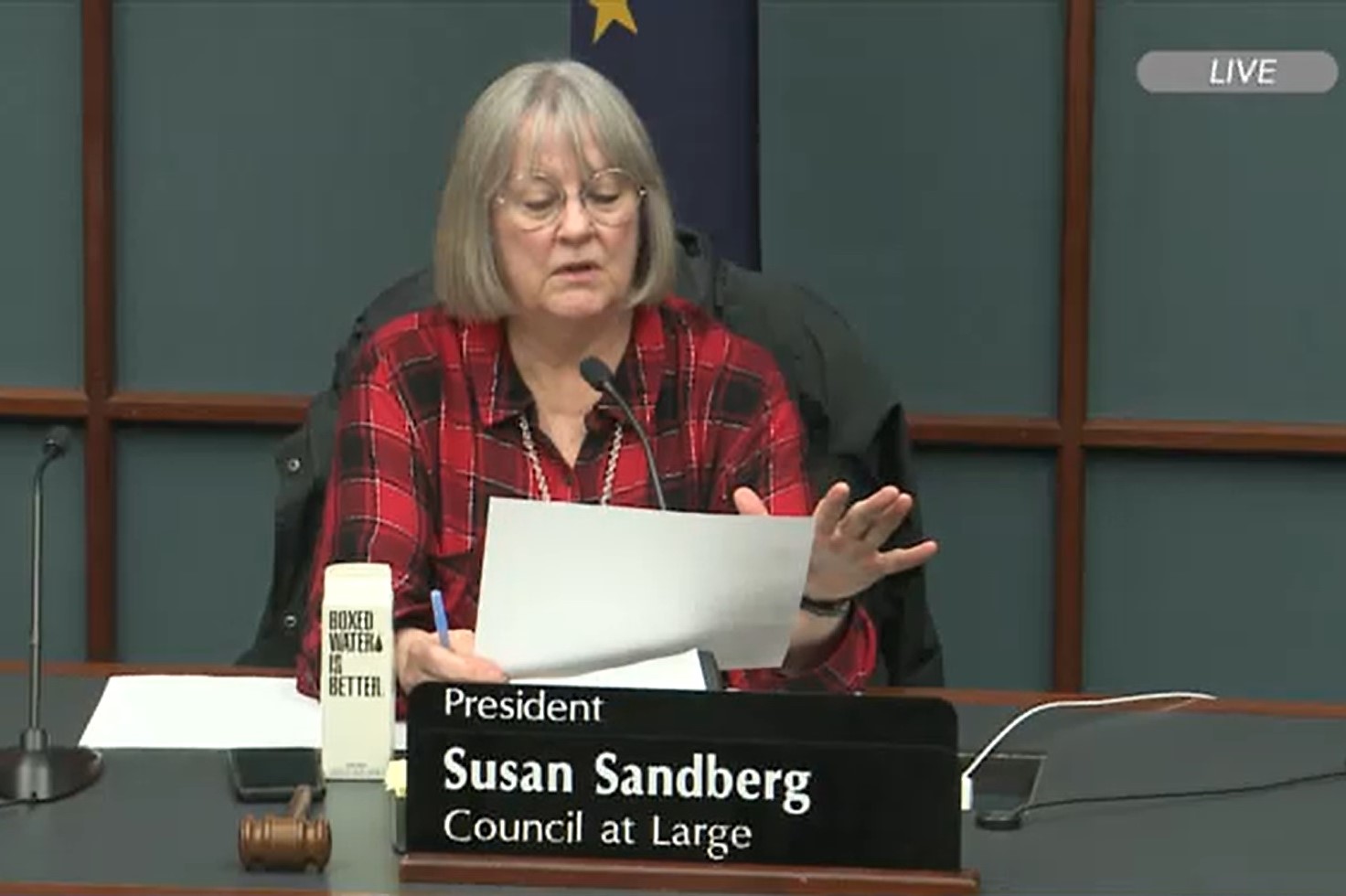
Former city council member and mayoral candidate Susan Sandberg testified as well. She was one of three council members who voted ‘no’ on the annexation ordinances.
She said she didn’t think city services could properly serve the annexation areas and decided to vote against annexation after learning how many county officials were upset about it.
One of Sandberg’s mayoral campaign platforms was to stop annexation.
Commissioners Julie Thomas and Penny Githens are listed as witnesses and will most likely testify on Friday.
UPDATE DAY THREE 5/01:
Three more city officials testified Wednesday in Bloomington’s annexation trial. The city called police chief Mike Diekhoff, fire chief Roger Kerr, and mayor Kerry Thomson to the stand.
First up though was Eric Reedy from Reedy Financial Group. Reedy is a Certified Public Accountant and founder of the group based in Seymour.
The Reedy company completed the required fiscal plan for Bloomington’s annexation and has since been hired by the city for other services including work for the redevelopment commission.
The 676-page fiscal plan shows its impact on residents, services, costs, financing methods, timing and extent of costs and revenue.
Reedy said some people will save money, nonprofits would pay less under annexation, but the average annexed resident would pay about $550 more a year in taxes.
Reedy said even with maximum cost estimates, the city and county can still provide services after annexation. The report shows bonds the city can take out to cover costs while tax revenues increase.
Attorney William Beggs during cross examination asked Reedy if he knew any of the people in 1A or 1B, owned real estate or had an office in Bloomington. He replied no.
Beggs noted the city paid Reedy Financial about $1 million since 2016 for its services.
“Do you wish to remain the city’s client?” Beggs asked. Reedy replied yes.
Beggs said the report shows a $1.6 million deficit without a bond to the city after annexation. “Is this in the best interest of the people?” Beggs asked. “Yes,” Reedy said.
Beggs also pointed out the local income tax increase that took effect a couple years ago is not included in the annexation fiscal report. The increase approved by city council gives the city about $14.5 in additional revenue – the county, Ellettsville, and Stinesville also get a boost.
Another big contention point is the number of police officers. The city is budgeted for 105 officers but has 86 positions filled. It’s been a trend for years. Reedy says cities budget with open positions all the time.
Police chief Mike Diekhoff agrees. He’s been chief for 17 years and with the department for 37 years. He called his staff adequate.
“We’re able to do our job with what we have,” he said.
He said areas 1A and 1B are not high-call volume areas, except for maybe shoplifting calls at some of the bigger box stores on the west side.
“We are already driving through those areas to get to the city. I don’t see it as a big draw,” he said.
Beggs noted with an average of two officers on duty in parts of the city at one time, the annexed areas would be a lot more ground to cover. He also said the city might have 86 officers on staff, but some of those are on leave for training, military, illness, or injury driving that number lower.
He said the Reedy report states at minimum, 14 more officers should be hired if areas 1A and 1B were annexed, leaving the city about 31 officers short.
Diekhoff said, “On paper, yes.”
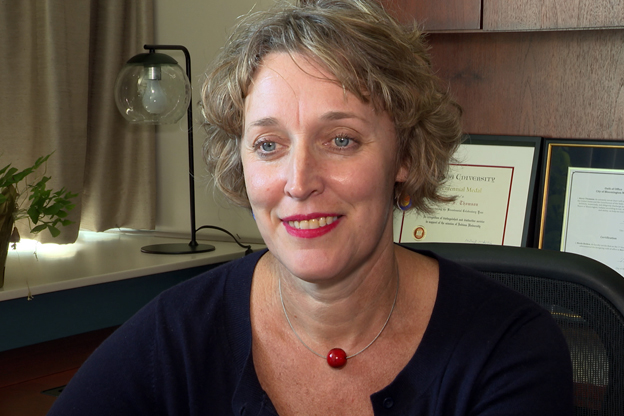
Thomson said the city can do it with the excellent police force they have already. They are hiring more officers and offering more benefits.
“We are staffed for what we need. The budget numbers are for what we’d like to get done,” Thomson said.
She said her top priority as mayor is affordable housing and vibrant economic development. She said the housing shortage is creating a workforce development issue.
Thomson said the county is reluctant to develop new neighborhoods and there are few developable tracts of land in the city.
She’s confident the city utilities can handle the proposed annexed areas with room to grow.
The cross examination included a few quotes from Thomson during the mayoral campaign suggesting she was against annexation.
“Cherry picking areas… city coffers diluting current services… already have vacancy in police… city is pushing a solution without discussing to those who are impacted,” to name a few.
Thomson replied that she said those things but meant she would have conducted annexation by a different process, and that she learned a lot more about annexation once she became mayor.
Beggs asked if she knew what’s best for the people of areas 1A and 1B, she replied no, but added, “I think as it pertains to how a city can either thrive or wither, how we’re doing collectively is important to economic development.”
UPDATE DAY TWO 4/30:
An urban policy consultant says it could take decades, but a city that doesn’t expand will slowly decline and become financially stressed.
David Rusk testified on behalf of the city Tuesday in the second day of the annexation trial of areas 1A and 1B at the Monroe County justice building.
He’s worked in more than 130 communities in 35 states and is the former mayor of Albuquerque.
Rusk used the term elasticity to describe thriving cities. He said cities that expand had higher bond ratings, lower fire insurance premiums, and more industrial and commercial growth.
“In an age of sprawl, higher income households move farther from the heart of the city,” Rusk said. “The city needs to expand to balance its socio-economic growth.”
He referenced Indiana University as a national research university and the primary focus of the region’s economy, arts, and entertainment.
He says if Bloomington didn’t grow, the city couldn’t have supported what the university is today.
County Residents Against Annexation attorneys asked how much the city paid for his report. He replied $30,500. Attorneys also noted that Rusk didn’t talk to any county officials or 1A and 1B residents for his report.
That’s a theme from CRAA’s opening statement Monday, that the people who know the most about areas 1A and 1B are the residents who live there.
Rusk said he doesn’t know the families, jobs, or problems of residents in the proposed areas, but his purpose is to present a framework of common long-term problems communities face in urban areas.
Attorneys questioned his comparisons to peer cities arguing their relation to Bloomington, as well as his source for fire insurance premiums. Rusk said he couldn’t get current data due to communication company proprietary records.
GIS manager Meghan Blair also finished testimony Tuesday. She said the 2020 census shows larger population densities resulting in greater than 3 people per acre in area 1B. That's one of two options in Indiana annexation statute for the written fiscal plan.
Judge Nathan G. Nikirk said to prepare for the trial to continue through Saturday due to the number of witnesses yet to testify.
Bloomington’s police chief, fire chief, mayor Kerry Thomson and four others are still expected to take the stand for the city. CRAA witnesses include Margaret Clements, former city council members, current county commissioners, and at least 20 residents.
UPDATE DAY ONE 4/29:
Day one of the five-day bench trial included opening statements and former mayor John Hamilton’s testimony.
The city continues to argue growth has led to urban development just outside city limits, even encouraging presiding Judge Nathan G. Nikirk to drive through proposed annexation areas 1A and 1B.
Those are the areas that obtained more than 51 percent of remonstrance petitions but less than 65 percent to void annexation.
County Residents Against Annexation attorneys said the percentages ended up being 61 percent for area 1A and 58 percent in 1B - a majority of residents who don’t want to be annexed.
Hamilton said he understands different viewpoints but it’s critical the city continues to expand to thrive. He said the areas in question were part of a two-mile fringe the county and city zoned decades ago in anticipation of annexation for urbanization.

CRAA lawyers said the city county interlocal expired and argued the case is about statute, and urbanization is not in the statute proceedings.
Former utilities director Vic Kelson, public works director Adam Wason, and GIS manager Meghan Blair also testified Monday.








